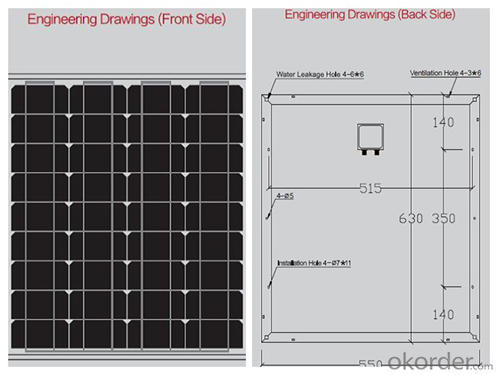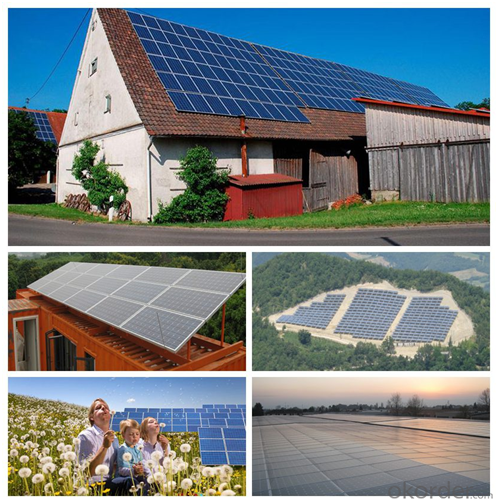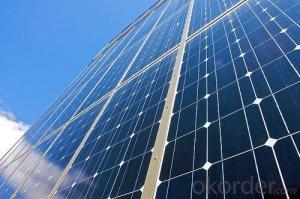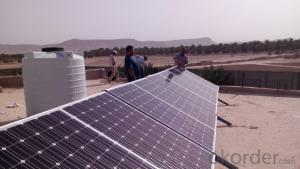Mono Solar panel ,Solar energy,Solar system
- Loading Port:
- China main port
- Payment Terms:
- TT OR LC
- Min Order Qty:
- 10000 watt
- Supply Capability:
- 100000000 watt/month
OKorder Service Pledge
OKorder Financial Service
You Might Also Like
Item specifice
Production description
Type:Solar Monocrystalline 125mm Panel Series
Excellent features:
1.High efficiency crystalline silicon solar cell. Even if under the weak light, the solar module can produce maximum power output.
2.Tempered glass (toughened glass): Anti-reflecting coating and high transmission rate glass increase the power output and mechanical strength of solar module.
3. EVA and TPT: Using high quality EVA and TPT to prevent destroying and water.
4. AI frame: Without screw, rner connection. 6 holes on the frame can be installed easily.
5. Junction box: Multi function junction box with water proof.
6. Long lifetime: ≥25 years; Less power decrease.
7. Good performance of preventing from atrocious weather such as wind and hails.
8. Resisting moisture and etching effectively, not effected by geology.
Certificate:UL,TUV,IEC,CE
Details
Characteristics
Max Power Voltage Vmp (V) | 17.4A | 17.8A |
Max Power Current Imp (A) | 2.59A | 2.81A |
Open Circuit Voltage Voc (V) | 22.4V | 22.6A |
Short Circuit Current Isc (A) | 2.75A | 2.99A |
Max Power Pm (W) | 45W | 50W |
Temperature Coefficient of Cells
NOCT | 47℃±2℃ |
Temperature Coefficients of Isc (%/ ℃) | +0.06% |
Temperature Coefficients of Voc (%/ ℃) | -0.33% |
Temperature Coefficients of Pmp (%/ ℃) | -0.45% |
Mechanical Data
Typeof Cells(mm) | Mono125 x 62.5 |
Dimension | 630x550x30mm |
Weight | 4.5kg |
NO. of Cells and Connections | 4x9=36 |
Images


FAQ
We have organized several common questions for our clients,may help you sincerely:
1.What price for each watt?
It depends on the quantity, delivery date and payment terms,
2.Can you provide the peripheral products of the solar panels, such as the battery, controller, and inverter? If so, can you tell me how do they match each other?
Yes, we can, we have two companies for solar region, one is CNBM International, the other is CNBM engineering Co.
We can provide you not only the solar module but also the off grid solar system, we can also provide you service with on grid plant.
- Q:I can't figure out how to charge a Ni Cd (BD 8V Firestorm) battery directly with a solar panel so I've come up with an alternative which might or might not work. I thought I would connect an inverter (I found a nice 400W for $30) to my trucks battery and plug the BD Firestorm battery charger into the inverter. Then I was thinking I could use a 5W solar panel to trickle charge the truck battery and keep it connected after the Ni Cd is charged to ensure the truck battery is topped off. The truck would not be running during this process. Will this solution work? Is there a better solution?
- Your 5W solar panel has to put out about 5 volts or higher to charge a 2 volt battery. 5 watts at 5 volts is only 0.3 amps, which is only enough to handle the internal leakage inside a large battery, plus a bit. If you have a 00 amp-hour battery, that panel would take 300 hours of bright sunlight to charge it. But I do agree that it will keep the truck battery charged as long as it gets sun. Make sure you put a diode in series between the panel and the battery to prevent the battery from discharging through the panel when the sun goes behind a cloud. I'd be worried that if you charged the 8 volt battery frequently, the panel would not be able to replace the lost charge, and your 2 volt battery would wind up discharged. That 8 volt battery is .2 amp-hrs (if I got the correct one). That is 27 watt-hours. Allowing for losses, you car battery will have to deliver over 30 watt hours to charge it. Your solar panel will take over 6 hours of bright sun to make up that difference. That is over 24 hours this time of year. So if you recharged it more than once every 2 days, you will lose charge in the truck battery. .
- Q:Can solar panels be installed on farmlands or agricultural fields?
- Yes, solar panels can be installed on farmlands or agricultural fields. In fact, many farmers and landowners are increasingly using their land for solar energy production as it can provide additional income and sustainable farming practices. Solar panels can be mounted on ground-mounted systems or integrated into structures like barns or sheds without interfering with farming operations. Additionally, solar installations can offer benefits such as reduced energy costs and promoting environmental sustainability in the agriculture sector.
- Q:Can solar panels be installed on a gas station or convenience store?
- Yes, solar panels can be installed on a gas station or convenience store. Installing solar panels on these establishments can help offset their energy consumption and reduce their carbon footprint. Additionally, it can lead to cost savings in the long run by generating clean and renewable energy.
- Q:if car companies install solar panels on cars, like in all the car were the sun can reach that would reduce the consumption of gas in the summer, and might save some energy for winter and if that energy is not enough they can use gas or electricity i think that would be a lot of savings, and less contamination i don't know that is my idea what do you people think?
- I have a panel that might be a square foot or so plugged into my cigarette lighter. It will run the radio and help with reducing the amount of time the alternator needs to run, but won't completely run the vehicle. If I had an electric vehicle, I'd want to coat any large surfaces with them. Still wouldn't completely run the vehicle, but every bit would help.
- Q:All I want to power is a small ice-maker (250 watts) for 25 minutes per day. That's all!!!Can I do that by using a 00 watt panel with 2-3 deep cycle batteries and getting 0 hours of quality light per day.(BTW) what size converter would you recommend? I want more than I need to grow the system
- You okorder /
- Q:Can solar panels be installed on a university or college campus?
- Yes, solar panels can be installed on a university or college campus. In fact, many educational institutions have already embraced renewable energy and have successfully installed solar panels on their campuses. These panels can help offset the electricity consumption of the campus, reduce carbon emissions, and provide a hands-on learning opportunity for students interested in sustainability and renewable energy.
- Q:Can solar panels be installed on a carport or parking lot?
- Yes, solar panels can be installed on a carport or parking lot. This is known as solar carport or solar parking lot systems. They provide shade for parked vehicles while generating clean and renewable energy.
- Q:We have LED at the output of 40 watts and is used for 0 hours giving us 400 Watts-hr of energy consumed.Rechargable batteries needed are 2 V. 400/2 gives us 34 Ampere-hour battery needed. If we want it for 3 days, It would be 34x3=00 Ah. So the battery needed 00 AhNow how do I select the solar panel which can charge this/these batteries? What should be its rating?
- First, you need to make sure that your battery can take a regular 34Ah discharge without damage. The usual wisdom when using deep cycle lead-acid batteries is to allow for no greater than 50% discharge. This is to prevent the battery from ageing prematurely. Note that automotive batteries are not usually considered suitable for deep-cycle applications. Best allow for at least 200Ah capacity. Your solar panel capacity needs to take into account that whatever the nameplate output of the panel, that will be what it will produce under ideal conditions, actual output will always be less, often quite a bit less. You also need to allow capacity to cope with dull, overcast days when the light level is very low. You can get solar maps that will give you the sunshine hours and irradiation levels at your location. The solar panel capacity ends up being a juggling act between available funds/space and how critical it is that the light always works as desired. Let's say you had a 400W panel, which sounds quite generous. In the middle of winter, it may produce only 75W for 5 hours on a dull day, not quite enough to run the light for 0 hours. Would you expect several such days in a row? How many days could a 00Ah of battery capacity cover under these conditions?
- Q:In some countries where electric generation is low, they are not available easily.
- Supply and demand, my friend.
- Q:I need to power a series of meraki wireless repeaters that plug into a standerd wall outlet. consuming 5v or .08 amps However I need this in a remote location (like out in the middle of nowhere) Using A solar panel as power supply and a battery to store the energy but, how and what do I use to convert the energy coming from the solar panel to the battery and the batteries power supply to match the needs of the meraki wireless repeater? How do I make this as compact as possible? Do I need a ac/dc converter? or dc/ac converter? Any suggestions or solutions would be great !
- First things first. 5 Volts @ .08 amps would be .2 Watts. therefore you would need at least the same amount from a solar panel to replenish the batteries. But what puzzles me is the notion that plugging it in a wall outlet ? If you use 20 V @ 0.08 then the power consumption is 9.6 Watts And what is a meraki wireless repeater? I never heard of one. I'm a FCC licensed Ham and have some idea what is available. If you need 5 volts DC, you could use twelve Ni-cads in series and just keep them trickle charged with the solar panel That would make it compact. If you were to use an automotive battery (or motorcycle), then you would need a DC/DC converter.
1. Manufacturer Overview |
|
|---|---|
| Location | |
| Year Established | |
| Annual Output Value | |
| Main Markets | |
| Company Certifications | |
2. Manufacturer Certificates |
|
|---|---|
| a) Certification Name | |
| Range | |
| Reference | |
| Validity Period | |
3. Manufacturer Capability |
|
|---|---|
| a)Trade Capacity | |
| Nearest Port | |
| Export Percentage | |
| No.of Employees in Trade Department | |
| Language Spoken: | |
| b)Factory Information | |
| Factory Size: | |
| No. of Production Lines | |
| Contract Manufacturing | |
| Product Price Range | |
Send your message to us
Mono Solar panel ,Solar energy,Solar system
- Loading Port:
- China main port
- Payment Terms:
- TT OR LC
- Min Order Qty:
- 10000 watt
- Supply Capability:
- 100000000 watt/month
OKorder Service Pledge
OKorder Financial Service
Similar products
New products
Hot products
Hot Searches
Related keywords






























